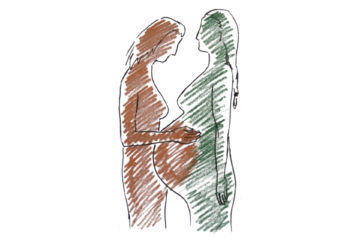It has been recognised for years that surrogacy law is in need of reform. The Law Commission of England and Wales and the Scottish Law Commission are currently drafting their long-awaited report on surrogacy, following consultation in 2019. A big feature of their reform agenda has been engagement with key stakeholders who have lived experience of surrogacy. In the consultation stage, the Commissions engaged widely with surrogates, intended parents, surrogacy organisations, legal practitioners and the Children and Family Court Advisory and Support Service.
One group that was missing, however, is children and young people. Perhaps this was due to an assumption that children have low legal literacy, that they will not have opinions on the law or that there are challenges in conducting research with children.
Given the new emphasis on engaging with all of those with lived experience of surrogacy, and the recognition of children as independent rights-holders whose views should be included in all matters affecting them, since the ratification of the United Nations Convention on the Rights of the Child, we thought the time was right to include children and young people's views in the debate.
What did we do?
We set up the Children's Voices in Surrogacy Law project to gather and analyse children's views on surrogacy law. The project is funded by the Institute of Medical Ethics and Research England. Phase One involved 25 children aged between eight and 17, with experience of surrogacy. They were either born through surrogacy (seven), the child of a surrogate (17), or the relative of a person who had used surrogacy (one). Phase Two involved 24 children of the same ages without experience of surrogacy. The three topics for discussion were: parenthood, contributions to surrogates and origin information and contact.
Research with children must be engaging and age-appropriate. So, we designed activities for each topic with a bespoke deck of playing cards. In some, participants voted on who they thought the parents should be after surrogacy arrangements, by choosing between cards depicting a surrogate, a surrogate and her partner, and intended parents. Participants sorted items, such as money, lost wages, maternity clothes, and gifts, into 'Yes', 'No', and 'Not sure' piles, depending on whether they thought intended parents should be allowed to give such items to surrogates. For the origin information topic, participants circled Yes', 'No', or 'Not sure' on a set of question cards asking who out of those involved in the conception process children should have knowledge of.
The advantage of this method was that children were actively participating, which held their attention. They answered these questions without hearing other responses, meaning they could not influence each other. We also had open questions and discussions, and a post-it activity, where participants brainstormed what they thought makes someone a parent. During the break, participants used an 'Art Corner' to make a creative contribution on the theme 'What Surrogacy Means to Me'. We later created a 'Digital Wall' of the artwork from the project.
The preliminary findings of Phase One of the project are available on our website. A report with the findings of Phase Two will follow shortly.
What did we find out in Phase One?
The children and young people saw love, care, responsibility and support as central features of parenthood. They also recognised that people become parents in different ways, with some mentioning 'having your own', IVF, adoption, surrogacy and fostering. The majority (22) of participants thought that the intended parents should be the legal parents of children born through surrogacy, with many focusing on the choices of the parties. For example, Jane (14, born through surrogacy) said:
''cos the intended parents chose to be the parents, and the surrogate chose to be a surrogate – not a parent.'
The majority (20) said that they would like to see a change to the current system which requires a parental order to transfer legal parenthood from the surrogate and her partner (if applicable) to the intended parent/s. Ellie (13, born through surrogacy) said:
'It's a bit unnecessary. I don't think going through a middleman is really… I don't see why it should be the surrogate at all in the first place.'
In addition, the majority (18) did not think that the surrogate should be able to change her mind and remain the legal parent.
When asked whether it was acceptable for money to be given to surrogates by intended parents (beyond expenses from the pregnancy), there were mixed results. Nine participants said yes, seven said not sure, and six said no. Some expressed a strong dislike towards payments for surrogates. Some were concerned that intended parents would be under pressure to pay large amounts. Children of surrogates were concerned about payment for surrogacy, as this would potentially undermine their mother's altruistic motivations. Two said that it would affect them negatively if they knew their mother was paid. Jack (17, child of surrogate) said that he would worry that his mother would be taking part in surrogacy to support the family financially and not because she enjoyed it.
Interestingly, all seven children born through surrogacy did not object to the idea of payment. They said that it would not really 'affect them' or they 'would not mind'. However, some of these children acknowledged how '[t]he child might feel like the only reason that the surrogate wanted to give birth to them is for the money.' (Scarlett, 11, born through surrogacy), or that she 'didn't want to bring them into the world' (Eliza, 11, child of surrogate).
Most participants were in favour of openness about origins, saying that children should know they were born through surrogacy (22), know who their surrogate was (21), know whether the arrangement was traditional or gestational (15), and know whether a donor egg or sperm was used (15). Participants drew on the ideas that it would be 'nice to know', that children 'deserve to know' and that they have 'a right to know'. Others said that openness depended on the parents' situation or that it might not be important for all children. Some participants drew on the idea of genetic relatedness for the question regarding the type of surrogacy (gestational or traditional) and donors. All participants were also very much in favour of continued contact between the families after the birth of the child, drawing on their own positive experiences involving meet-ups at parks and leisure centres, walking the dog, having food, birthday parties and family Christmases.
All participants were open about surrogacy in their lives, but also noted how their peers knew little about surrogacy, which led them to explaining it to them. There was also general agreement that very little was taught in schools about surrogacy. Two participants, aged 15 and 16, mentioned advocating for surrogacy because it is not talked about enough and there was a need to reduce stigma.
What's next?
We presented the Phase One findings to the Law Commissions in September 2022. We then conducted Phase Two with children in schools and a preliminary report is being developed. It will be really interesting to compare the findings from those with experience of surrogacy to the findings from those who do not.
Conducting this research with children has been incredibly rewarding, for us and the participants. We know this from their feedback forms, with one saying 'thank you for being respectful and listening to us'. We also think that it is incredibly important research to undertake; there is no other way to understand how law impacts children during childhood other than to ask children. If we do not ask them, we can only guess and assume through the eyes of adults. In their own words: we need to be respectful and listen to them.






Leave a Reply
You must be logged in to post a comment.